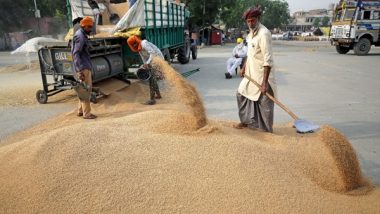New Delhi [India], May 26 (ANI): Weeks after the Central government banned wheat exports to control price rise, the Centre on Wednesday announced that India exported wheat worth USD 177 million in March and USD 473 million in April this year.
The government data highlighted that while India's expected production of wheat for 2022-23 remains at near 105 million metric tonnes (MMT), it needs to fulfil domestic consumption requirements for its 130 crore population (30 MMT required for food security schemes such as National Food Security Act (NFSA), Pradhan Mantri Garib Kalyan Anna Yojana (PMJKAY) and other welfare schemes for near 80 crores poor and vulnerable population) while also providing humanitarian assistance to neighbouring countries and other vulnerable nations.
The government said that 42.7 MMT of wheat has been distributed under NFSA and PMGKAY in FY 2021-22.
"Among the wheat exporting countries, India ranked 19th in 2020, 35th in 2019, 36th in 2018, 36th in 2017, 37th in 2016, which shows that India has an insignificant share (0.47 per cent) while seven countries (Russia, the USA, Canada, France, Ukraine, Australia, Argentina) have the largest share in the overall quantity of wheat export in the past five years. A negotiation-based approach instead of conflict would have prevented removal of nearly a quarter of wheat exports from Russia and Ukraine," the data read.
Also Read | Jack Dorsey Steps Down From Twitter's Board of Directors.
It further read, "Still, after the conflict began on February 24, 2022, India has exported wheat worth USD 177 million and USD 473 million in March 2022 and April 2022 respectively despite facing challenges of low wheat production as a result of an extreme heat wave that enveloped the northern part of the country that caused shrivelled grains and resulted in drop in yield per acre."
Sources earlier this month said that the government's wheat procurement dropped by 53 per cent so far in the 2022-23 marketing year as compared to the year-ago period due to aggressive buying by private players for export purposes.
The government data on Wednesday further mentioned that the export restrictions have been a regular feature of major food producers which has adversely affected India too. On the other hand, India has taken the step towards the regulation of wheat exports in order to ensure food security of India, its neighbours and vulnerable countries.
On the front of restrictions on wheat, there are at least eight countries (excluding India) such as Egypt, Turkey, Kazakhstan, Kyrgyzstan, Kuwait, Kosovo, Ukraine, Belarus etc which have exercised export restrictions on wheat that are still in force. Egypt and Turkey have also been importing a significant quantity of wheat from India and have no locus standi for asking for open exports after having restricted them.
In the past few months some other countries such as Argentina and Hungary had banned wheat exports, but now have moved away from those restrictions. Russia removed export duties but due to trade embargo by Western countries, it is not able to export, the government said.
In addition, a number of other food products have been restricted for exports. These include vegetable oil restrictions by Indonesia (palm oil), Argentina, Kazakhstan, Cameroon, Kuwait etc. Indonesia's decision to ban palm oil exports despite the country accounting for around a third of all vegetable oil exports (Palm oil comprises near 60 per cent of global vegetable oil shipments), had a major impact on countries (such as Bangladesh, Pakistan, India) who were dependent heavily on Indonesia to meet their domestic requirements. These have resulted in a significant price rise and India has been at the receiving end of these.
The procurement of wheat in Rabi Market Season (RMS) 2022-23 has been 180 lakh metric tonnes (LMT) compared to 400 LMT last year in RMS 2021-22 (i.e. 45 per cent). This is due to the fact that the farmer got a better price than MSP in the open market, as confirmed by market survey reports and field offices, even without visiting the Mandi at most places. This is also evident from the fact that procurement on May 16, 2022 and May 17, 2022 has been merely 31,349 MT and 27,876 MT respectively compared to 3,80,200 MT and 1,46,782 MT respectively in the previous year on the same days (i.e. only 8.2 per cent and 19 per cent).
Further, the 180 LMT procurement in RMS 2022-23 has been also due to the relaxation in Fair Average Quality (FAQ) norms of shrivelled grains of wheat (from 6 per cent to 18 per cent) by the Central Government. This has facilitated the farmer to sell the produce at MSP to the government which was otherwise selling in an open market at a lesser price, thus safeguarding the financial security of farmers. (ANI)
(This is an unedited and auto-generated story from Syndicated News feed, LatestLY Staff may not have modified or edited the content body)














 Quickly
Quickly

















